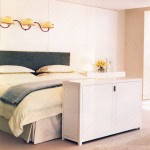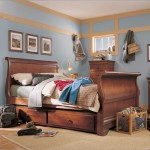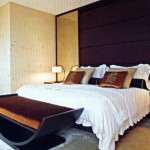23 May Getting a Feng Shui Foothold on Footboards
Lately, for some reason, questions have been coming my way from clients as well as students about footboards. Knowing that a headboard holds significant meaning in terms of feeling supported in the bed as well as in life, the obvious question reolves around the other end of the bed—-what about a footboard?
There is really only one situation when someone would want a footboard, although an argument could be3 made that generally having one is better than not having one. The specific instance when a footboard is crucial is when the bed is positioned so that the bottoms of the feet are pointing directly out the door of the bedroom. This is often called the “Feet Out the Door Position” for obvious reaons, or the “Death Position, for not so obvious ones. This latter situation is tied to traditional thinking, Chinese and otherwise, that when someone dies in the house, their bodies would be taken feet first out of the room, symbolically guiding the person’s feet towards their next path. Although that tradition isn’t relevant any more, the connection to death hasn’t, well, died. This is a set-up we try to avoid.
For some, having a footboard completes the feel of the bed. When a client is feeling at loose ends and may even de scribe themselves as not being able to put one foot in front of the other, or can’t get their feet moving, or feel like they’re not walking on solid ground—–I suggest a footboard to symbolically provide them a sturdy spot to rest their feet at night.
scribe themselves as not being able to put one foot in front of the other, or can’t get their feet moving, or feel like they’re not walking on solid ground—–I suggest a footboard to symbolically provide them a sturdy spot to rest their feet at night.
Footboards come in different varities—-some are attached to the bedframe and complement the headboard. Strength and sturdiness are the operative words in terms of an appropriate footboard. Open slats and decorative iron work may not provide the solid footing you’re looking for. If your bedframe didn’t come with a footboard, then you can create one—-with a bench, plants, a quilt stand. Anything that is a little bit taller t han your feet will qualify as a footboard. The only thing you want to avoid when mocking up a footboard is that it doesn’t become so high that you can no longer see past your feet when you’re lying in bed. Now you’ve defeated the purpose of a footboard by blocking your vision. This would happen if you have a sleigh bed.
han your feet will qualify as a footboard. The only thing you want to avoid when mocking up a footboard is that it doesn’t become so high that you can no longer see past your feet when you’re lying in bed. Now you’ve defeated the purpose of a footboard by blocking your vision. This would happen if you have a sleigh bed.
I haven’t come across a sleigh bed owner who doesn’t love their bed above all else. Any suggesti on of changing it is out of the question. They love how it cradles them and makes them feel safe. If they assure me their quality of sleep and their general level of well-being and purpose are all good, I may suggest a crystal above the bed for overall balance and then let them sleigh away.
on of changing it is out of the question. They love how it cradles them and makes them feel safe. If they assure me their quality of sleep and their general level of well-being and purpose are all good, I may suggest a crystal above the bed for overall balance and then let them sleigh away.
Many people do not have footboards and are doing just fine. However, if you feel the need to stress the importance of solid footing in your life, then a footboard can supply you a constant reminder of just that intention.
